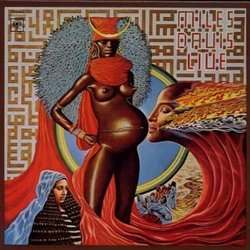"Can the ocean be described?"
finulanu | Here, there, and everywhere | 11/08/2007
(4 out of 5 stars)
"Anyone who follows Wynton Marsalis on the warpath against fusion should listen to this album at least once. It will show them how wrong he is about the genre "commercializing" jazz. Live-Evil is not music made for the general public at all. Suggesting otherwise is simply an insult to the album. This is the closest Miles Davis got to perfecting his merge of jazz, rock, funk, avant-garde, African ritual music; psychedelia and voodoo music. It's an eerie, trippy, often captivating album that succeeds in doing everything B*tches Brew did, plus a bit it didn't do, in an even better fashion. Half of it is live, and the live work is stellar: four lengthy, jaw-dropping tunes. "Sivad" passes through rock, funk, big-band jazz and avant-garde. "What I Say" is a funky tour-de-force that is almost guaranteed to keep you on the edge of your seat for all of its twenty minutes, with intense playing all around and a colossal, power-packed groove akin to a shambling mountain. Subtly is forgotten: Miles and saxman Gary Bartz wail away; Keith Jarrett hammers the piano; McLaughlin contributes slashing, machine-gun fire leads; Jack DeJohnette thrashes the spit out of his drums; Michael Henderson keeps the whole mess along with a mesmeric but danceable bass. And then Jack DeJohnette shows up everyone who ever attempted a drum solo before or afterwards. Seriously, that is my favorite drum solo ever. "What I Say" is one of my favorite Miles Davis songs ever, which is certainly saying something. The only weak tracks on the first side are two short studio cuts: "Nam Un Talvez" is drab; and "Little Church" is art for art's sake. Even then, the third studio cut ("Gemini/Double Image") is a wonderful funky Hendrix imitation. "Selim", another studio cut, is pretty much a second take of "Nam Un Talvez", and it isn't really better either. "Funky Tonk" is the weakest of the live tracks, and it's pretty far from bad - solid, steady groove, fantastic organ. It just wanders a bit, that's all. But it winds its way back to awesomeness eventually. After that, you get a brilliant keyboard solo that sounds almost like Eastern music. Among many other things, this is an amazingly diverse record. And then the wonderful fusion cacophony "Inamerata and Narration" comes along and saves the day. And that poetic monolog is sweet. I took my review title from it.
So as a live album this gets full marks (his best live album ever), but the studio half is only running on a quarter-tank of gas. Thankfully, there's about an hour and a half of live material, and just over fifteen minutes of studio stuff - nine of them abominable, six of them amazing. So if you treat the studio work as a bunch of bonus tracks, you'll do fine with this one.
By the way, the cover art is easily the most suggestive (and most trippy) in Miles' history, making Big Fun's look like an innocuous little picture of some early-'60s whitebread rock group by comparison. It (a pregnant, exaggeratedly aroused, head-dressed woman, for those who don't have the cover art handy) and your image on the back (meant to be some sort of combination of a demon and J. Edgar Hoover in drag) give you a great idea of what's gonna go on in the music itself. For the record, I have reason to believe this is a concept album of sorts about the duality of nature - compare the front and the back side-by-side, look at track names like "Gemini/Double Image", and think hard about the song titles "Sivad" and "Selim". You'll get what I mean. By the way, the studio half really is "evil", if by "evil" you mean "bad" and by "bad" you mean "abysmal" (other than "Gemini/Double Image", which is amazing). So the title really makes sense now! By the way, I pretty much hated this (besides "What I Say") when I first heard it. But now it's become one of my favorite Miles discs. And I've heard over 40 of 'em, so don't say I don't know my stuff. Because I do.
Oh, and no matter how much I rave about this one, In a Silent Way, Big Fun, and Dark Magus, none of them are good entry points for new Miles fans, even if they're coming from a rock bent. I'd advise that they start with the Second Great Quintet "acoustic fusion" discs (E.S.P.; Miles Smiles; Nefertiti; Sorceror; Miles in the Sky, which does have a bit of guitar; Filles de Kilimanjaro, which mixes acoustic and electric jazz but doesn't quite do the full monty, so to speak). Or buy some contemporary Herbie Hancock and Mahavishnu Orcehstra fusion discs (I'd recommend Hancock's Headhunters and Man-Child and the Orchestra's Inner Mounting Flame and Visions of the Emerald Beyond especially), which are just as artistically successful, and very accessible as well. But this is great, if inaccessible."


 Track Listings (5) - Disc #1
Track Listings (5) - Disc #1